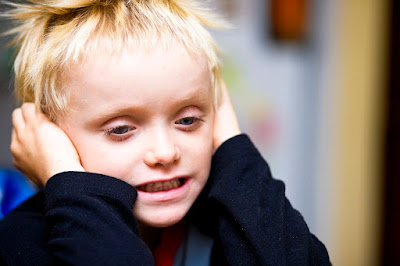In many cases, self-injury begins as a means of communication.
Often a child is trying to convey a feeling or idea they may not be able to
express in words. Biting, headbanging or other self-injury behaviors may be
attempts to express pain, fear, displeasure, or anxiety. Self-injury can
also be a form of sensory stimulation. An individual with autism may
self-injure as a way to increase or decrease their level of arousal. An
increased understanding of the incidence and risk factors associated with SIB
in autism is needed to develop treatment options.
Research
A study in the Journal of Autism
and Developmental Disorders assessed 7 factors that may influence self
injury in a large group of 250 children and adolescents with ASD: (a) atypical
sensory processing; (b) impaired cognitive ability; (c) impaired functional
communication; (d) deficits in social interaction; (e) age; (f) the need for
sameness; and (g) ) compulsive or ritualistic behavior. Other factors that may
influence SIB incidence such as gender and ASD severity were also assessed. A
series of diagnostic tests were administered either directly to the children
and adolescents or to their parents to assess: (a) autism severity; (b)
cognitive and adaptive ability; (c) and receptive and expressive language; (d)
repetitive behaviors; and (e) self-injury.
The results indicated that
half of the children and adolescents demonstrated SIB. Atypical sensory
processing was the strongest single predictor of self-injury followed by
sameness, impaired cognitive ability and social functioning. Age, impaired
functional communication, and ritualized behavior did not contribute
significantly to self-injury. No significant effects of gender or severity of
autistic symptoms were found in the study.
Implications
Self-injurious behavior is an important public health problem in individuals with autism spectrum disorder (ASD). SIB is a debilitating behavior that occurs in a significant proportion of children, teens, and adults with ASD. Atypical sensory processing and the need for sameness were contributors to SIB in this study. Research has also found significant associations between SIB and behavioral (aggression, hyperactivity, anxiety) developmental (adaptive behaviors, nonverbal IQ), and somatic (sleep and GI problems ) factors. Current and previous research findings support the need for a comprehensive and multidisciplinary approach for assessing and managing SIB in ASD. It is critical that interventions that target the risk factors associated SIB be identified and implemented in clinical practice. Providing empirically supported behavioral interventions to autistic individuals with self-aggressive behavior will not only impact directly on the problem behavior, but will their enhance social, educational, and adaptive functioning as well. Further research is clearly needed to better understand additional contributing factors that may influence these complex behaviors in children with ASD. For example, temperament, ability to self-regulate emotions, and medication usage might contribute to increased self injury.
Key References
Christensen
T, Ringdahl J, Bosch J, et al. (2009). Constipation associated with self-injurious and
aggressive behavior exhibited by a child diagnosed with autism. Education
& Treatment of Children, 32, 89–103.
Devine D. (2014). Self-injurious behaviors in autistic children: a neuro-developmental theory of
social and environment isolation. Psychopharmacology, 231, 979–997.
Duerden,
E. G., Oatley, H. K., Mak-Fan, K. M., McGrath, P. A., Taylor, M. J., Szatmari,
P., & Roberts, S. W. (2012). Risk factors associated with self-injurious
behaviors in children and adolescents with autism spectrum disorders. Journal
of Autism and Developmental Disorders, 42:2460–2470. DOI
10.1007/s10803-012-1497-9
Mahatmya,
D., Zobel, A., & Valdovinos, M. G. (2008). Treatment approaches for
self-injurious behavior in individuals with autism: Behavioral and
pharmacological methods. Journal of Early and Intensive Behavior Intervention,
5, 106-118.
Moseley,
R. L., Gregory, N. J., Smith, P., Allison, C., & Baron-Cohen, S. (2019). A
'choice', an 'addiction', a way 'out of the lost': exploring self-injury in
autistic people without intellectual disability. Molecular autism, 10,
18. doi:10.1186/s13229-019-0267-3
Soke, G.
N., Rosenberg, S. A., Hamman, R. F., Fingerlin, T., Rosenberg, C. R.,
Carpenter, L., … DiGuiseppi, C. (2017). Factors associated with self-injurious behaviors in children with autism spectrum disorder: Findings from two large national samples. Journal of autism and developmental disorders, 47(2),
285–296. doi:10.1007/s10803-016-2951-x
Summers,
J., Shahrami, A., Cali, S., D'Mello, C., Kako, M., Palikucin-Reljin, A., …
Lunsky, Y. (2017). Self-Injury in autism spectrum disorder and intellectual disability: Exploring the role of reactivity to pain and sensory input. Brain
sciences, 7(11), 140. doi:10.3390/brainsci7110140
Waters,
P., & Healy, O. (2012). Investigating the relationship between self-injurious behavior, social Deficits, and co-occurring behaviors in children
and adolescents with autism spectrum disorder. Autism research and
treatment, 2012, 156481. doi:10.1155/2012/156481
Wilkinson, L. A. (2017). Best practice in special education. In L. A. Wilkinson, A best practice guide to assessment and intervention for autism spectrum disorder in schools (pp. 157-200). London and Philadelphia: Jessica Kingsley Publishers.
Lee A. Wilkinson, PhD, NCSP is a licensed and nationally certified school psychologist, and certified cognitive-behavioral therapist. He is author of the award-winning books, A Best Practice Guide to Assessment and Intervention for Autism and Asperger Syndrome in Schools and Overcoming Anxiety and Depression on the Autism Spectrum: A Self-Help Guide Using CBT. He is also editor of a text in the APA School Psychology Book Series, Autism Spectrum Disorder in Children and Adolescents: Evidence-Based Assessment and Intervention in Schools. His latest book is A Best Practice Guide to Assessment and Intervention for Autism Spectrum Disorder in Schools (2nd Edition).
















No comments:
New comments are not allowed.